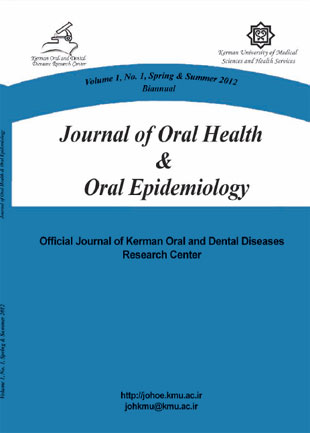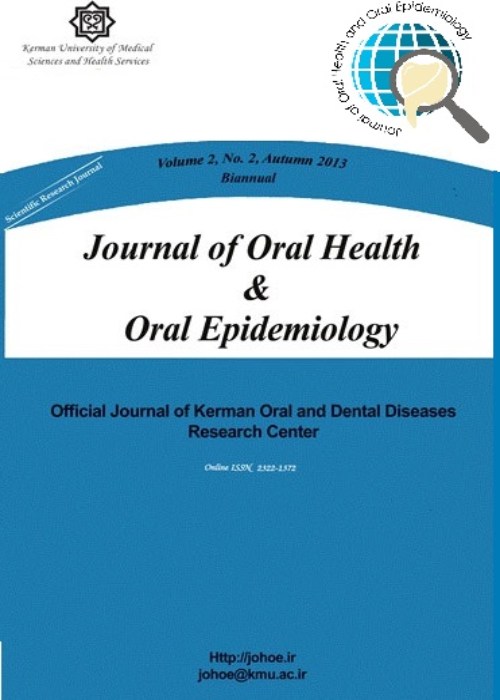فهرست مطالب

Journal of Oral Health and Oral Epidemiology
Volume:1 Issue: 1, Winter-Spring 2012
- تاریخ انتشار: 1391/12/19
- تعداد عناوین: 8
-
-
Page 1Learning statistics is a necessity for dental researchers. Due to daily dental science expansion, dental researchers have to study new papers in recent dental journals to remain up to date. On the other hand, knowing principles of statistics helps better understanding of the articles. Some authors revealed that knowledge of dentists about basic topics of statistics was poor. Therefore, in this series of articles, we will discuss some statistical topics as self-learning tool.Keywords: Dental researcher, statistics, epidemiology
-
Page 3Guided bone regeneration (GBR) is a reconstructive procedure of alveolar ridge using membranes. This procedure is indicated when there is no sufficient bone for implantation, or in the case of optimal implant installation for esthetic or functional needs. GBR can be performed before implant placement, when there is not enough bone for initial stability of implants and less predictable outcomes (staged approach), or performed simultaneously with implantation (combined approach). GBR techniques have been used for vertical and horizontal ridge augmentations with acceptable results. This literature review discusses the background, principles of GBR, the materials used in GBR (types of membranes and bone grafts), success criteria and long term results of GBR.Keywords: Guided bone regeneration, graft materials, dental implants, alveolar ridge augmentation
-
Page 19BackgroundThis study was designed to assess the knowledge and attitude of male students of Kerman primary schools about 0.2% sodium fluoride mouthwash solution that students used it once a week.MethodsIn this cross-sectional study, a total of 502 boys, eight to nine year-old and students of Kerman primary schools were selected for the study. The data related to their knowledge and attitude about the sodium fluoride mouthwash were collected by questionnaire.ResultsThe boy students’ knowledge about the sodium fluoride mouthwash solution was good but their attitude was negative.ConclusionsThe oral health education program concerning the optimal use of the fluoride mouthwash in dental caries prevention is highly recommended. It is suggested that its taste is improvedKeywords: Knowledge, attitude, mouth rinse, fluoride
-
Page 23BackgroundA wide range of oral health conditions has been studies in disabled populations. Many studies showed that the oral health of individuals who were disabled was poor and their oral treatment needs were greater than those of the general population. This study aimed to determine caries experience, levels of oral hygiene,periodontal health and prevalence of malocclusion in a sample of disabled subjects.MethodsFive special care needs schools were randomly selected from the list of schools in Kerman and all attendants were examined for dental status on the basis of WHO criteria, gingival health and oral hygiene behaviors. Data were analyzed by ANOVA and chi-square tests.ResultsThere were 297 participants in the study. The most frequent group of disability was mental retard. The mean decayed, missing and filled teeth (DMFT) score was 5.14. Ninety percent of subjects had gingival inflammation. There was no significant (P = 0.34) difference between caries experiences of different disable groups.ConclusionsOral hygiene of disabled groups was poor and their caries experience rate was very high. Special oral health care program for them is recommended.Keywords: Special care, oral health, oral hygiene, disability
-
Page 29BackgroundCaries is an infectious disease that is induced by the diet. Despite its decline in all age groups on a worldwide basis, it is still a serious public health problem in children and its control should be a priority. It has been demonstrated that dental caries can gradually reduce children's weight gain, which may be reversed after complete oral rehabilitation. The main aim of this study was to examine the relationship between dental caries and body mass index (BMI) in a sample of young children in Iran.MethodsA random sample of 420 children aged 6 years was examined for dental caries using WHO standard diagnostic criteria. Decayed, missing and filled of primary teeth (dmft) and permanent teeth (DMFT) were recorded. The children’s weight and height were measured using standard digital scales by two trained examiner and their BMI were calculated BMI and dental caries categoris association was tested by chi- square analysis.ResultsThe mean decayed, missing and filled teeth score of the study population was 4.70 ± 3.4. Only 9% of the children were underweight and 6% were obese when they were compared with WHO standard of BMI for children with the same age. There was a significant association (P = 0.04) between BMI and dental caries categories.ConclusionsAn association was observed between DMFT and BMI of participants. The relationship should be investigated by further longitudinal studies.Keywords: Body Mass Index, dental caries, children
-
Page 36BackgroundOropharyngeal candidiasis is a common infection in patient receiving radiotherapy for head and neck cancer. Accurate and rapid identification of candida species is very important in clinical laboratory, because the incidence of candidiasis continues to rise after radiotherapy. The genus Candida has about 154 species that show different level of resistance to antifungal drugs and have high degree of phenotypic similarity. The aim of this study was to investigate oral yeast colonization and infection and resistance to antifungal drugs in these patients.MethodsThirty patients receiving a 6-week course of radiation therapy for treatment of head and neck cancer at the Oncology Unit in Shafa Hospital, in 2008, were enrolled in the study. Specimens from patients were cultured weekly for Candida. All isolates were plated on CHROM agar and RPMI-based medium. They were subcultured and submitted for antifungal susceptibility testing (nystatin, fluconazole, clotrimazole and ketoconazole) and molecular typing.ResultsInfection (clinical and microbiological evidence) occurred in 50% of the patients and Candida colonization (only microbiological evidence) occurred in 70% of subjects in the first week. Candida albicans alone was isolated in 94.9% of patient visits with positive cultures. Candida tropicalis was isolated from 5.1% of patient visits with positive cultures. All isolates were susceptible to nystatin, but did not respond to the other antifungal drugsConclusionsThe irradiation-induced changes of the intraoral environment such as xerostomia lead to increased intraoral colonization by Candida species. All yeast isolates were susceptible to nystatin. Thus prophylactic therapy with nystatin should be considered for these patients.Keywords: Oropharyngeal candidiasis, radiation, colonization, antifungal drugs, cancer
-
Page 41Backgroundß -estradiol is a steroid sex hormone that plays important role in oral physiology. The aim of this study was to determin the association of the menstrual cycle and salivary ß-estradiol with the production of volatile sulfur compounds (VSC).MethodsIn this cross-sectional study, twenty female dental students in good oral and general health were recruited for evaluation of VSC, salivary flow, ß-estradiol concentration, oral dryness feeling and dysmenorrhea. Data were analyzed by marginal homogeneity test and xtgee model.ResultsThe only covariates that significantly related to VSC were being at the follicular phase (B = -0.21, P = 0.02), being at the pre-menstrual phase (B = -0.25, P = 0.01), stressfulness (B = 0.02, P = 0.01) and oral dryness feeling (B = 0.34, P = 0.02). Salivary ß-estradiol was at the level of 59.7 ± 31.2 in those having halitosis (VSC ≥ 75) while in the others (VSC < 75) it was about 40.8 ± 18.0 (P < 0.009). This difference was not statistically significant in multivariate analysis.ConclusionsThe menstrual cycle, stress and oral dryness were the most important determinants of halitosis. The salivary ß-estradiol level could not explain such relationship as its effect was eliminated considering the other factors.Keywords: Halitosis, menstrual cycle, ß, estradiol, volatile sulfur compound
-
Page 46Hemangiomas are tumors of blood vessels identified by rapid endothelial cell proliferation in early infancy followed by involution over time. All other abnormalities are malformations resulting from anomalous development of vascular plexuses. This lesion in the oral cavity is not common. Despite its benign origin and behaviour, it is always of clinical importance to the dental profession and requires appropriate management. This paper reports a rare case of cavernous hemangiomaof base of tongue, buccal mucosa and floor of mouth with extensive phleboliths in a 64-year-old male.Keywords: Oral, hemangiomas, vascular malformation, phlebolith, tongue, buccal mucosa


